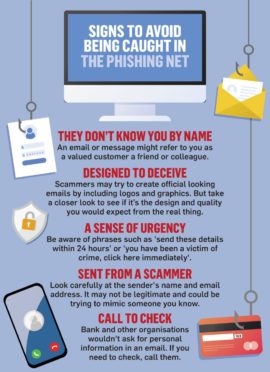Most people think they wouldn’t fall for a cyber scam – but some are so sophisticated it’s easy to see why someone could be fooled.
Criminals carrying out phishing and vishing scams use email, texts and phone calls to target their victims – often sending multiple messages at a time.
And while typos, stilting sentences and strange email addresses are often clear signs they are not who they say they are – some scams are more subtle.
Tactics used by scammers
The National Cyber Security Centre warns people what to look out for, and among the signals that scammers are at work include:
- Generic greetings such as valued customer, friend or colleague
- Flaws in the design – they may try to recreate logos of known companies, but look closely and you may see it’s not quite right
- The wording might convey a sense of urgency with phrases such as ‘you have been a victim of crime’…and then urging you to click on a link.
- The sender’s name and address may also try to mimic someone you know, but may not be legitimate
- Banks and other organisations shouldn’t ask for personal information by email, if you need to check call them.
‘Don’t give your details out’
Citizens Advice Scotland has advice on its site to help people who are worried about scams.
Among the issues the organisation highlights is the rise of such crimes during the pandemic.
CAS says: “If you see emails or texts about coronavirus from someone you don’t know, or from an unusual email address, don’t click on any links or buy anything.
“Don’t give money or personal details to anyone you don’t know or trust – for example someone who knocks on the door and offers to help.”
In particular, it urges people to watch out for the following to avoid falling victim to covid scams:
- advertising face masks or medical equipment at high prices
- emails or texts pretending to be from the government
- emails offering life insurance against coronavirus
- people knocking at your door and asking for money for charity
How to keep the criminals out
The NCSC suggests taking measures to stay out of reach from fraudsters, they include:
- Review privacy settings on social media and other accounts
- Think about what you post and who can see it
- Change your phone number to be unlisted
What to do if you are hit by scammers
CAS advises people who have been affected by scams to take steps to protect themselves.
- If you have transferred money to a scammer call police right away
- Reset your passwords
- Let your bank know your financial information might have been stolen
- Make sure you update your anti-virus software
- If you think your PIN or account details have been stolen contact your bank
- If you have lost money because of a scam check if you can get your money back
To report a scam contact Police Scotland.
Scams can also be reported to Advice Direct Scotland.



